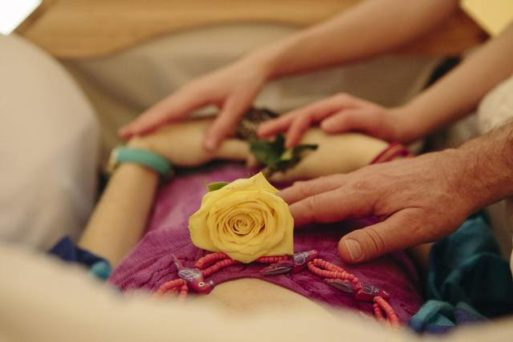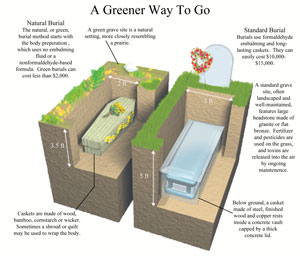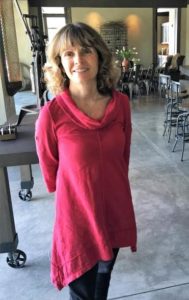Today SevenPonds speaks to Akhila Murphy, a trained death-care midwife who has been practicing since 2013. Murphy’s job is to help families create beautiful personalized memorial services for loved ones inside their own homes. In this first part of our two-part interview, Akhila discusses the fundamental responsibilities of her job, the path she took to become a death-care midwife, and her ideas for the future of the profession.

Credit:www.star-telegram.com
Kristen: Can you describe what your job entails?
Akhila: Being a death-care midwife means that I work to inform people about end-of-life and after-death options. This might include guiding a memorial service for a loved one who has died and/or offering ideas as to conducting home funerals and green burials. Most people don’t realize that home funerals are legal in all 50 states. This means families have the right to care for their loved one in the privacy of their own homes.
Death-care midwives encourage people to create a comfortable atmosphere in their homes for the dying. We help guide families through the dying process and assist in preparations for a home funeral. Death care midwives may sit vigil with a loved one or suggest how to arrange different grief rituals, such as decorating the casket, dressing the body or preparing the body to lie in honor.
These loving practices really bring into question why we stopped caring for loved ones at home in the first place, which they still do in many other countries. Our job really is to encourage families to bring back the tradition of caring for their loved ones at home during dying, and to complete the care with home funeral and disposition such as green burial. We’re really looking to change the paradigm.
Kristen: What are green burials?
Akhila: A green burial is a way for someone’s body to return to the earth once they have died. It’s actually been practiced for thousands of years, and, if done right, does the least amount of environmental damage. The body is buried without the use of a cement vault. Embalming is not required. The body can be placed in an eco-friendly casket made of wood, cardboard, or bamboo, without toxic glues or nails, or be wrapped in a shroud. The person is placed directly into the grave so that decomposition can happen naturally. After the body is buried, usually family members like to mark the place of the burial.
Most green burial cemeteries are an environmentally friendly setting without lawns, which require fuel burning mowers and the use of pesticides. They may allow people to leave a simple marker such as an engraved natural stone, or use GPS coordinates to mark the graves. It’s a really beautiful tradition.

Green Burial vs. Traditional Burial
Credit: www.natwincities.com
Kristen: Can you mention some specific differences between a conventional funeral and a home funeral?
Akhila: Sure. Most of the home funerals I guide take place in either the person’s home or a relative’s home, rather than at a funeral parlor. It’s interesting because, in our great-grandparents’ day, they had rooms called parlors that were specifically designated for laying out a loved one’s body so visitors could come and pay their respects. With this old tradition, families were in charge of completing their loved one’s death care process.
Home funerals allow family and community to spend as much time as needed with the loved one who has died in a comfortable, familiar environment. With conventional funerals, a mortician processes the body and only allows a limited amount of time for the funeral service, which happens in an unfamiliar setting, such as a mortuary. Allowing for extra time with the loved one gives families time to process that their loved one is gone, which helps the grief process. They may also create their own ceremonies, which may include singing songs, telling stories, washing and dressing the body, and creating a sacred space using their own religious or spiritual traditions. Death-care midwives, also known as home funeral guides, are there to guide them through the process and support the grief they feel while taking care of their loved one. It really becomes a sacred space for all involved.
Kristen: How did you get started in the practice?

Akhila Murphy
Credit: Akhila Murphy
Akhila: Before becoming a death-care midwife, I volunteered in hospice, which is where I became very interested in the process of how people should be cared for at the end of life. Then I took a training class with Final Passages, which is a program developed by death-care educator Jerrigrace Lyons, who has been offering training in home funerals for nearly 20 years. The training is a two-part session covering two five-day weekends. We participated in role playing, watching death-related films, listening to guest speakers and learning about creating sacred space. We also learned how to completely care for a body after death, how to have the person lie in honor, and how to consult with families about our work. Lastly, we learned about being a guide, and how to be an educator and supporter of all aspects of death and dying, including knowledge of different laws and what paperwork needs to be filled out.
After completing the training program, I co-founded an organization called Full Circle Living & Dying Collective, which works to educate the community about all aspects of death and dying; encourage conversations about death and advance planning; and guide families through their own home funerals.
Kristen: Would you say being a death-care midwife is a job most people know about?
Akhila: Not at all. It’s not something that is known because people usually avoid conversations about death and dying. But I think it’s a subject that should be talked about more. Through Full Circle Living & Dying Collective, we’ve been engaging the public in conversations about death and letting people know that they can create their own support system so they don’t have to go through the dying process alone.
Join us again next week for part two of our interview, where Akhila Murphy will tell us more about her unique profession and offer advice to those struggling with the loss of a loved one.

 What is a Death Care Midwife? An Interview with Akhila Murphy: Part One
What is a Death Care Midwife? An Interview with Akhila Murphy: Part One


 Our Monthly Tip: Make an “In Case of Death” File to Ease Loved One’s Grief
Our Monthly Tip: Make an “In Case of Death” File to Ease Loved One’s Grief
 Passing of Beloved Comedian Births a New Comedy Festival
Passing of Beloved Comedian Births a New Comedy Festival















